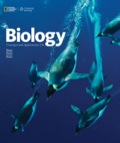
Concept explainers
Introduction:
The cell is the basic “fundamental unit” of life. Every organism present in the environment is composed of cell. Cells perform a number of important activities that help in the survival of an organism. These activities are known as cellular activities.
Answer to Problem 1SQ
Correct answer:
All the cells have three basic structures. These are plasma membrane, cytoplasm, and DNA. Hence, the correct answer is option c.
Explanation of Solution
Reason for correct answer:
Option c. is given as “cytoplasm, DNA, and a plasma membrane.”
Every cell contains three basic structures that form a complete cellular unit. These three structures are:
• Plasma membrane:
The outer layer of cell that acts as a barrier is known as the plasma membrane. It surrounds all the cellular units and protects them from the external environment.
• Cytoplasm:
It is the middle layer of the cell. All the internal components of the cell are present in the cytoplasm.
• DNA:
DNA stands for “Deoxyribonucleic acid.” It is the genetic material present in the organisms that guide them to perform all the cellular activities.
Therefore, every cell contains these three basic units (plasma membrane, cytoplasm, and DNA).
Reason for incorrect answer:
Option a. is given as, “cytoplasm, DNA and, organelles with membranes.”
Every cell contains cytoplasm and DNA. The cell can have two types of organelles, one with membrane and other without a membrane. This indicates that it is not necessary that a cell contains an organelle with a membrane. Hence, option a. is incorrect.
Option b. is given as, “a plasma membrane, DNA, and a nuclear envelope.”
Plasma membrane and DNA are two important components that are present in every cell. However, it is not necessary that every cell has a nuclear envelope. For example, prokaryotes lack nuclear envelope but eukaryotes contain a well-defined nuclear membrane. Hence, option b. is incorrect.
Option d. is given as, “a cell wall, cytoplasm, and DNA..”
Every cell contains a cell wall and DNA. However, every cell does not contain a cell wall. For example, the plant cell has a cell wall but animal cells lack a cell wall. Hence, option d. is incorrect.
Hence, the options a., b., and d. are incorrect.
The three basic components present in every cell are cytoplasm, plasma membrane, and DNA. Thus, the correct option is c.
Want to see more full solutions like this?
Chapter 4 Solutions
EBK BIOLOGY: CONCEPTS AND APPLICATIONS
- Using quail and chicken embryos, what kind of experiment would you conduct to test if rib forming somites have their axial identity specified before segmentation? How do we know this phenotype is due to axial identity being specified before segmentation and not due to our experimental method?arrow_forward8. Aerobic respiration of a 5 mM solution of tripeptide that is composed of the following three amino acids; alanine, leucine and isoleucine. Alanine breaks down to pyruvate, leucine breaks down to Acetyl-CoA and isoleucine breaks down to succinyl-CoA. Alanine NADH FADH2 OP ATP SLP ATP Total ATP Leucine Isoleucine Totals Show your work using dimensional analysis here: 4arrow_forward9. Aerobic respiration of one lipid molecule. The lipid is composed of one glycerol molecule connected to two fatty acid tails. One fatty acid is 12 carbons long and the other fatty acid is 18 carbons long in the figure below. Use the information below to determine how much ATP will be produced from the glycerol part of the lipid. Then, in part B, determine how much ATP is produced from the 2 fatty acids of the lipid. Finally put the NADH and ATP yields together from the glycerol and fatty acids (part A and B) to determine your total number of ATP produced per lipid. Assume no other carbon source is available. fatty acids glycerol 18 carbons 12 carbons 0=arrow_forward
- If using animals in medical experiments could save human lives, is it ethical to do so? In your answer, apply at least one ethical theory in support of your position.arrow_forwardYou aim to test the hypothesis that the Tbx4 and Tbx5 genes inhibit each other's expression during limb development. With access to chicken embryos and viruses capable of overexpressing Tbx4 and Tbx5, describe an experiment to investigate whether these genes suppress each other's expression in the limb buds. What results would you expect if they do repress each other? What results would you expect if they do not repress each other?arrow_forwardYou decide to delete Fgf4 and Fgf8 specifically in the limb bud. Explain why you would not knock out these genes in the entire embryo instead.arrow_forward
- You implant an FGF10-coated bead into the anterior flank of a chicken embryo, directly below the level of the wing bud. What is the phenotype of the resulting ectopic limb? Briefly describe the expected expression domains of 1) Shh, 2) Tbx4, and 3) Tbx5 in the resulting ectopic limb bud.arrow_forwardDesign a grafting experiment to determine if limb mesoderm determines forelimb / hindlimb identity. Include the experiment, a control, and an interpretation in your answer.arrow_forwardThe Snapdragon is a popular garden flower that comes in a variety of colours, including red, yellow, and orange. The genotypes and associated phenotypes for some of these flowers are as follows: aabb: yellow AABB, AABb, AaBb, and AaBB: red AAbb and Aabb: orange aaBB: yellow aaBb: ? Based on this information, what would the phenotype of a Snapdragon with the genotype aaBb be and why? Question 21 options: orange because A is epistatic to B yellow because A is epistatic to B red because B is epistatic to A orange because B is epistatic to A red because A is epistatic to B yellow because B is epistatic to Aarrow_forward
 Concepts of BiologyBiologyISBN:9781938168116Author:Samantha Fowler, Rebecca Roush, James WisePublisher:OpenStax College
Concepts of BiologyBiologyISBN:9781938168116Author:Samantha Fowler, Rebecca Roush, James WisePublisher:OpenStax College
 Human Physiology: From Cells to Systems (MindTap ...BiologyISBN:9781285866932Author:Lauralee SherwoodPublisher:Cengage Learning
Human Physiology: From Cells to Systems (MindTap ...BiologyISBN:9781285866932Author:Lauralee SherwoodPublisher:Cengage Learning





